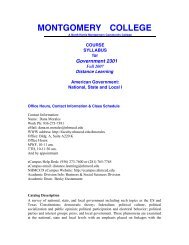2008 - Communication Across the Curriculum (CAC)
2008 - Communication Across the Curriculum (CAC)
2008 - Communication Across the Curriculum (CAC)
Create successful ePaper yourself
Turn your PDF publications into a flip-book with our unique Google optimized e-Paper software.
R e s e a r c h P a p e r<br />
BIOL 2401: Anatomy and Physiology I. This report<br />
by Ana Maria Castro is an outstanding example of<br />
a research paper completed as part of <strong>the</strong> Anatomy<br />
and Physiology I course writing requirement. The<br />
report is a good example of <strong>the</strong> proper use of peerreviewed<br />
journal articles. Locating and using peer<br />
reviewed articles is a skill that many students find<br />
difficult. This report is also outstanding because it<br />
exemplifies <strong>the</strong> style of writing (tone, conciseness)<br />
that scientists use. Additionally, <strong>the</strong> report effectively<br />
and correctly uses figures, ano<strong>the</strong>r important science<br />
writing skill that not many of <strong>the</strong> students choose to<br />
develop (not a requirement for <strong>the</strong> assignment).<br />
Kathryn Gronlund<br />
Chagas’ Disease<br />
by Ana Maria<br />
Castro<br />
Abstract<br />
Chagas’ disease or American trypanosomiasis is a tropical<br />
disease prevalent in Latin American countries. It is a disease<br />
caused by <strong>the</strong> protozoan Trypanosoma cruzi which is transmitted<br />
to humans and animals by kissing bugs of <strong>the</strong> family reduviidae.<br />
The disease has three phases: acute, latent, and chronic and<br />
<strong>the</strong> symptoms vary from phase to phase. In <strong>the</strong> acute phase<br />
<strong>the</strong> symptoms are mild, but <strong>the</strong> parasitemia is high. When <strong>the</strong><br />
infection progresses, symptoms such as cardiomegalias and<br />
viseromegalias increase, but <strong>the</strong> parasitemia is low. The chronic<br />
disease is often fatal; however, <strong>the</strong>re are two drugs used to treat<br />
<strong>the</strong> disease: Benznidazol and Nifurtimox.<br />
Discussion<br />
Cause<br />
Chagas’ disease or American tripanosomiasis is produced<br />
by a protozoan known as Trypanasoma cruzi (Figure 1). This<br />
organism is a flagellate of <strong>the</strong> Kinetoplastida Order, Family<br />
Trypanosomatidae, characterized by <strong>the</strong> presence of a flagellum<br />
and a single mitochondrion in which is situated <strong>the</strong> Kinetoplast,<br />
a specialized DNA-containing organelle (Brusca 133). The<br />
vectors of this disease are hematophagus commonly known<br />
as kissing bugs of <strong>the</strong> family Reduviidae and genus Rhodnius,<br />
Triatoma, and Panstrongylus (Brusca 614). These insects get<br />
infected when <strong>the</strong>y suck <strong>the</strong> blood of an animal or human that<br />
has <strong>the</strong> parasite in its circulatory system. Within <strong>the</strong> digestive<br />
tube of <strong>the</strong> bug, <strong>the</strong> protozoan evolves and <strong>the</strong> infective stage<br />
V o l u m e I V : F a l l 2 0 0 8<br />
1 0






